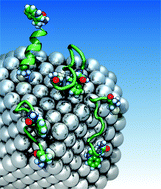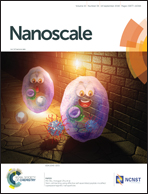Effect of nanosilver surfaces on peptide reactivity towards reactive oxygen species†
Abstract
The interaction of a terminal tryptophan residue within collagen mimetic peptides when tethered to nanometric silver surfaces was studied using a combination of steady state spectroscopy, ultrafast spectroscopy, and molecular dynamics experiments. Our findings indicate that the effective interaction between the tryptophan and the metal surface occurs in short-time scales (ps) and it is responsible for improving the colloidal stability of the nanoparticles exposed to free radicals. The extent and efficiency of the interaction depends on factors beyond the peptide length that include conformation and distance from the terminal tryptophan to the metal surface.



 Please wait while we load your content...
Please wait while we load your content...